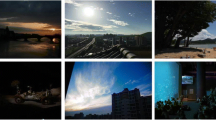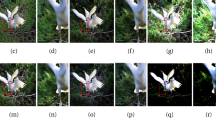Abstract
Most existing low-light image enhancement methods enhance whole low-light image indiscriminately with the neglect of its subjective content, which may lead to over-enhancement and noise amplification problems in background. In this paper, we explore the challenging subjective low-light image enhancement problem. To this end, we first develop a novel foreground saliency detection model to measure the subjective content of low-light images. It is achieved by learning a saliency map and a depth map of low-light images based on CNN technique, and then fusing the two maps based on the Guided filter. Then, we incorporate the foreground saliency map model into a general retinex-based low-light image enhancement framework. Experimental results show that the proposed method well improves the subjective perception of low-light images without amplifying the noise in background compared with existing methods.










Similar content being viewed by others
References
Abdullah-Al-Wadud M, Kabir MH, Dewan MA et al (2007) A dynamic histogram equalization for image contrast enhancement. IEEE Trans Consum Electron 53(2):593–600
Ban SW, Jang YM, Lee M (2011) Affective saliency map considering psychological distance. Neurocomputing 74(11):1916–1925
Borji A, Cheng MM, Jiang H et al (2015) Salient object detection: a benchmark. IEEE Trans Image Process 24(12):5706–5722
Bruce N, Tsotsos J (2007) Attention based on information maximization. J Vis 7(9):950–950
Cai J, Gu S, Zhang L (2018) Learning a deep single image contrast enhancer from multi-exposure images. IEEE Trans Image Process 27(4):2049–2062
Fan Q, Qi C (2016) Saliency detection based on global and local short-term sparse representation. Neurocomputing 175:81–89
Fan DP, Lin Z, Zhang Z et al (2020) Rethinking RGB-D salient object detection: models, data sets, and large-scale benchmarks. IEEE Trans Neural Netw Learn Syst. https://doi.org/10.1109/TNNLS.2020.2996406
Fu X, Zeng D, Huang Y, et al (2016) A weighted variational model for simultaneous reflectance and illumination estimation. In: Proceedings of 2016 IEEE conference on computer vision and pattern recognition (CVPR)
Fu K, Zhao Q, Gu IYH, Yang J (2019) Deepside: a general deep framework for salient object detection. Neurocomputing 356:69–82
Fu K, Fan DP, Ji GP, Zhao Q (2020) Jl-dcf: joint learning and densely-cooperative fusion framework for rgb-d salient object detection. In: Proceedings of the IEEE/CVF conference on computer vision and pattern recognition, pp 3052–3062
Godard C, Mac Aodha O, Firman M, Brostow GJ (2019) Digging into self-supervised monocular depth estimation. In Proceedings of the IEEE international conference on computer vision, pp 3828–3838.
Guo X, Li Y, Ling H (2017) Lime: low-light image enhancement via illumination map estimation. IEEE Trans Image Process 26(2):982–993
He K, Sun J, Tang X (2010) Guided image filtering. In: Proceedings of European conference on computer vision, pp 1–14
He K, Zhang X, Ren S, Sun J (2016) Deep residual learning for image recognition. In: Proceedings of 2016 IEEE conference on computer vision and pattern recognition (CVPR)
Itti L, Koch C, Niebur E (1998) A model of saliency-based visual attention for rapid scene analysis. IEEE Trans Pattern Anal Mach Intell 20(11):1254–1259
Jiang M, Huang S, Duan J, Zhao Q (2015) SALICON: saliency in context. In: Proceedings of the IEEE conference on computer vision and pattern recognition (CVPR)
Jing H, He X, Han Q et al (2014) Saliency detection based on integrated features. Neurocomputing 129:114–121
Jobson DJ, Rahman Z (1997) Properties and performance of a center/surround retinex. IEEE Trans Image Process 6(3):451–462
Karel Z (1994) Contrast limited adaptive histogram equalization. Graphics Gems.
Land EH (1977) The retinex theory of color vision. Sci Am 237(6):108–128
Loh YP, Chan CS (2019) Getting to know low-light images with the exclusively dark dataset. Comput Vis Image Underst 178:30–42
Lore KG, Akintayo A, Sarkar S (2015) Llnet: a deep autoencoder approach to natural low-light image enhancement. Pattern Recogn 61:650–662
Marcella C, Lorenzo B, Giuseppe S, Rita C (2018) Predicting human eye fixations via an lstm-based saliency attentive model. IEEE Trans Image Process. https://doi.org/10.1109/TIP.2018.2851672
Murray N, Vanrell M, Otazu X, Parraga CA (2011) Saliency estimation using a non-parametric low-level vision model. In: Proceedings of 2011 IEEE computer vision and pattern recognition (CVPR), pp 433–440
Pizer SM, Amburn EP, Austin JD et al (1987) Adaptive histogram equalization and its variations. Comput Vis Graph Image Process 39(3):355–368
Rahman ZU, Woodell GA (2002) Multi-scale retinex for color image enhancement. In: Proceedings of IEEE international conference on image processing
Scharstein D, Szeliski R (2002) A taxonomy and evaluation of dense two-frame stereo correspondence algorithms. Int J Comput Vision 47(1–3):7–42
Shen L, Yue Z, Feng F, et al (2017) Msr-net:low-light image enhancement using deep convolutional network. Arxiv
Tavakoli HR, Laaksonen J (2016) Bottom-up fixation prediction using unsupervised hierarchical models. In Proceedings of Asian conference on computer vision, pp. 287–302
Wang C, Ye Z (2005) Brightness preserving histogram equalization with maximum entropy: a variational perspective. IEEE Trans Consum Electron 51(4):1326–1334
Wang N, Li Q, Abd El-Latif AA (2012) An accurate iris location method for low quality iris images. In: Proceedings of fourth international conference on digital image processing (ICDIP 2012)
Wang S, Zheng J et al (2013) Naturalness preserved enhancement algorithm for non-uniform illumination images. IEEE Trans Image Process 22(9):3538–3548
Wang Y, Wang H, Yin C, Dai M (2015) Biologically inspired image enhancement based on retinex. Neurocomputing 177(177):373–384
Wei C, Wang W, Yang W, et al (2018) Deep retinex decomposition for low-light enhancement. In: proceedings of British machine vision conference (BMVC)
Yan H, Zhang S, Zhang Y, Zhang L (2018) Monocular depth estimation with guidance of surface normal map. Neurocomputing 280:86–100
Yu F, Koltun V (2016) Multi-scale context aggregation by dilated convolutions. In: International conference on learning representations.
Zhang M, Ren W, Piao Y, et al (2020) Select, supplement and focus for RGB-D saliency detection. In: Proceedings of the IEEE/CVF conference on computer vision and pattern recognition, pp 3472–3481
Zhang T, Abd El-Latif AA, Wang N, et al (2012) A new image segmentation method via fusing NCut eigenvectors maps. In: Proceedings of fourth international conference on digital image processing (ICDIP 2012).
Zhao JX, Cao Y, Fan DP, et al (2019) Contrast prior and fluid pyramid integration for RGBD salient object detection. In: Proceedings of the IEEE conference on computer vision and pattern recognition, pp 3927–3936
Zhao JX, Liu JJ, Fan DP, et al (2019) EGNet: edge guidance network for salient object detection. In: Proceedings of the IEEE international conference on computer vision, pp 8779–8788
Acknowledgements
This work was supported by the National Key R&D Program of China (Grant No. 2021YFB2401904).
Author information
Authors and Affiliations
Corresponding author
Additional information
Publisher's note
Springer Nature remains neutral with regard to jurisdictional claims in published maps and institutional affiliations.
Rights and permissions
About this article
Cite this article
Hao, P., Yang, M. & Zheng, N. Subjective low-light image enhancement based on a foreground saliency map model. Multimed Tools Appl 81, 4961–4978 (2022). https://doi.org/10.1007/s11042-021-11590-9
Received:
Revised:
Accepted:
Published:
Issue Date:
DOI: https://doi.org/10.1007/s11042-021-11590-9




